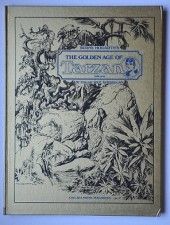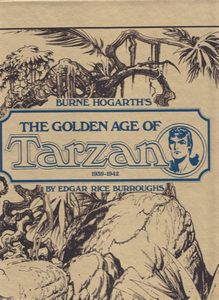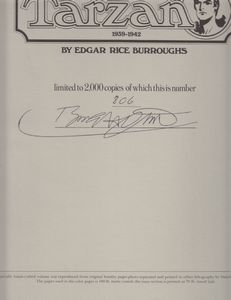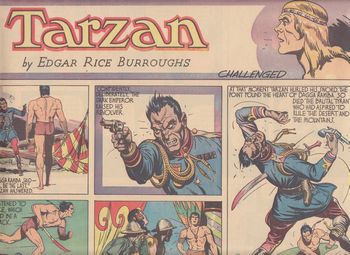Golden Age of Tarzan
| série: | Tarzan Sunday Pages |
| dessinateur / scénariste: | Hogarth Burne |
| éditeur: | Chelsea EO 1977 |
| genre: | Aventure |
| classement: | biblio1 |
| date: | 1977 |
| format: | hardbook in the original cardboard |
| état: | TBE/N |
| valeur: | 200 € |
| critère: | **** |
| remarques: | hardbook in a cardboard, size 15 x 20 inches, 154 pages, signed and numbered facsimile edition, limited to 2000 volumes of which this one has the number 806 and is signed by Hogarth 1/ contents 2/ the many faces of Tarzan by Maurice Horn - Maurice Horn is a recognized authority on comics and cartoons (world encyclopedia of comics) - this volume is a publishing milestone in the history of comic art, reprinting exactly a collection of Sunday Pages in full colour and in their original size (36 x 50 cm = 15 x 20 inches) reproducing some of the best episodes of Tarzan's adventures drawn by Burne Hogarth - biography of Edgar Rice Burroughs (1875-1950) who finally became succesful as an author of popular fiction and especially with the creation of Tarzan in 1912, at the time of his death Burroughs left no fewer than 45 original Tarzan novels - 1918 Tarzan was brought to cinema but of all the media in which Tarzan has appeared, the comics (1928) have been the most truthful to Tarzan's image and legend and the comics reached their highlight with the drawing of Burne Hogarth after that of Foster who had also developed a remarkable drawing technique - after Foster and Hogarth, the other artists of Tarzan were: - William Juhré (1947) - Dan Barry (1947-1949) - John Lehti (1949) - - Paul Reinman (1949-1950) - Cardy = Nicholas Viskardy (late 1950) - - Bob Lubbers (1950-1953) - John Celardo (1953-1967) and Russ Manning (1967-1973) - the first original Tarzan comic book was offered 1948 by Gold Key Comics (in France 1936 by Hachette) - 1972 Tarzan passed to DC Comics with Joe Kubert taking charge of the new version, 1977 Tarzan moved to Marvel Comics >> p. XI analysis of the work of Burne Hogarth - the pages reproduced in this volume extends from May 1939 to April 1942, they may justly be termed Tarzan's Golden Age as the Lord of the jungle has emerged from the shadow of Foster into his rightful artistic place 3/ Tarzan, a myth-man in the age of the macromachine by Burne Hogarth - man himself is a disease and nature with all its phenomenal powers has not been able to disrupt the planet with such pervasive unrelenting persistence as has humandkind - the technological world is now taking place, it is the age of the machine - in this technical environment and during the time of depression, Burroughs created a new myth: the myth-man, an authentic hero, the archetype of every man's secret desire to be liberated from frustration and despair - Burroughs became one of the most-read and highest-paid writers (togethe with H.G. Wells, Jack London and Conan Doyle), however Burroughs was misunderstood and rejected by his professional peers 4/ Tarzan's episodes n.b. for a detailed summary of the four following stories of Tarzan, see volume 8,9, 10 and 11 (1994/1995) of Flying Buttress edition by Bill Blackbeard, president of the Academy of Comic Art a) Tarzan and the Amazons (21.5.1939 to 23.7.1939 = 10 pages) b) Tarzan and the Boers, 2nd story (30.7.1939 to 18.4.1940 = 40 pages) c) Tarzan and the peoples of the sea and of fire (5.5.1940 to 27.4.1941 = 52 pages) d) Tarzan against Dagga Ramba (4.5.1941 to 26.4.1942 = 52 pages) >> a sublime volume with regard to the quality of graphism and colour, all of that edited in the original size of the Sunday Pages, an unique masterpiece! |
| couvertures: |     |
Copyright 2008 - 2025 G. Rudolf
